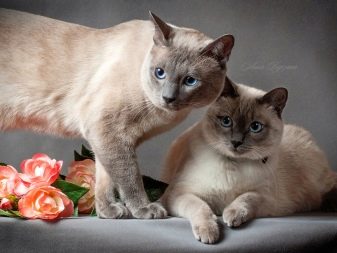Siamese cat breed is very popular around the world. The appearance of animals is recognizable and familiar to many. However, the Siamese is often confused with the Thai breed. If you put two representatives of different breeds side by side, then you can easily notice the differences. Moreover, animals have a different character.


History of breed origin
For many years, Thais and Siamese were considered representatives of the same breed. The confusion is connected with the fact that cats appeared in the state of Siam, known to us as Thailand. The first cats to appear were outwardly similar to modern Thai, but they were called Siamese. Under this name, they began to be exported to other countries. Later, the selection gave the world another breed, which received the identical name.
Representatives of Siamese cats of those times had external differences, so it was decided to still separate the breeds. The second officially became Thai, since the first Siamese were already widespread throughout the world. Despite the same homeland, the story of cats is different.



The modern Siamese breed has been known for over 600 years. At home, cats were equated with saints. The law protected these animals, they were highly respected and were honored participants in various rituals. Cats did not leave Thailand for a long time; their export was prohibited at the legislative level.
The Siamese began to travel only at the end of the XIX century. Europeans gladly accepted the breed, made its representatives exhibitors. Already in 1892, the standard of Siamese breed cats was prescribed.Over time, the appearance of the animals changed, large ears appeared, a special shape of the head and more refined paws.
The modern Thai breed is also called Old Siamese or traditional Siamese. Today's appearance of cats is very similar to the Siamese of the XVIII century. In the "Book of poems about cats" (XIV century) you can find a description and images of representatives of the breed. Thais were residents of royal houses and Buddhist shrines. The breed was officially recognized under a well-known name only in 1990, and the standard was approved even later.



Differences in appearance
Cats are confused due to the similar color of the muzzle, ears, paws and tail. These parts are different from the main body color. However, the differences are quite noticeable if you know what to pay attention to. So, the characteristic differences.
- Thai cat has a small and well-built body. Siamese breed, in turn, is distinguished by leanness, flexibility. The body of the representatives looks elongated, as if elongated. If we compare the representatives of both breeds, then the Thais are larger, more muscular and dense. The weight of an adult can reach 8 kg.
- Thais differ in paws of medium length. Siamese limbs are longer and thinner.
- The difference in tails is noticeable. Siamese breed is long and thin, like a whip, and Thai - medium and thicker.
- Thais have a rounded muzzle, and Siamese have a wedge-shaped. In the latter, the tips of the ears and nose fold into an equilateral triangle.
- The profile varies tremendously. Thais have it with a small hollow at eye level. Siamese cats have an almost straight profile.
- Siamese have a slanting, almond-shaped eye shape. The eyes of representatives of another breed are large and round.
- The ears of Thais have rounded tips, they are small in size and look quite proportional. In the Siamese breed, the ears are large, wide, with sharp tips.
- Both breeds do not have a sublayer. The coat is short and silky.
- Eye color is the same - light blue.


Character difference
You can distinguish between breeds not only in appearance. There are characteristic differences in the temperament and behavior of animals. Be careful, the character may differ from the personal characteristics of cats, from the place of residence and upbringing.
Representatives of the Thai breed are quite individual in nature. Usually they are balanced and calm. A manifestation of curiosity and attention to detail is characteristic. Thais are pretty smart cats. They are very amenable to training and are able to learn even non-standard teams.
Thais love their masters, get used to them. At the same time, they rarely show jealousy and easily get along with both children and other animals. Leaving them alone for a long time is not worth it. With a long time alone with himself, the cat may begin to have problems with the psyche. Playing with the Thais is fun and safe, they practically do not release their claws.
The breed is very talkative. They are able to make various sounds when communicating with the owners. This greatly distinguishes Thais from Siamese. The breed is characterized by active facial expressions. One look at the face allows you to determine the mood of the animal.


Representatives of the Siamese breed love their owners. This feeling is always accompanied by increased jealousy. If a cat is treated badly, often scolded, beaten and punished, then her character will deteriorate. The animals are very loud. They often yell than meow habitually.
These cats will scream until they receive increased attention to their person. They need to be given a lot of attention, they are very playful and need it. If the owner is absent for a long time, then the cat becomes apathetic, ceases to be interested in what is happening around. Along with this, the representatives of the breed are very freedom-loving and are distinguished by independence, independence. Expect full obedience from them.
Training is possible only with a careful and individual approach. You need to communicate with the Siamese affectionately and calmly.Any manifestation of cruelty is unacceptable in education.

Other distinctive features
External signs and differences in temperament are understandable and easily verifiable. There are other signs by which it is possible to distinguish the representatives of the breeds with more detailed observation. Cats have different accommodations. Thais avoid conflicts with other animals, never lift up the smaller and weaker. If you offend the cat, he will simply ignore such an act.
In contact with children, Thais show not just love, but a kind of maternal instinct, special care. When communicating with a child, a representative of the breed does not use teeth and claws. With them there are no cases when the games turn into attacks.
Siamese cats are indifferent to all strangers and animals. If you try to pet the animal at the wrong time, you can encounter a rather aggressive reaction. The cat treats its relatives well and warmly. It is difficult to predict the behavior when a new tenant appears due to jealousy.
Cats really like to play with children. Leaving them unattended is not worth it. For Siamese, often simple amusements turn into aggression. They can release claws, bite.

Health in cats is also different. Thais live an average of 12-18 years, and sometimes can live up to 28 years. Representatives of the breed are susceptible to diseases of the musculoskeletal system, there are arthritis and joint dysplasia. Among diseases of the genitourinary system, cystitis, urocystitis, and urolithiasis are found. Thais are not susceptible to diseases caused by bleeding disorders and inflammation of the inner eyelid.
Siamese cats live on average 10-20 years, can live longer with proper care. It is known about the record holder who pleased his hosts for 38 years. Cats can suffer from impaired protein metabolism, which leads to amyloidosis of the liver or kidneys. The owners should be responsible for the state of the cardiovascular system. Cardiomyopathy occurs, which can lead to heart failure and death.
Siamese can have an inborn squint. Violation of the thyroid gland leads to the appearance of hyperthyroidism. Eyes are generally considered a weak spot in cats of this breed, so sometimes they suffer from increased intraocular pressure, glaucoma.



How to distinguish a kitten yourself?
The difference between Siamese and Thais is already obvious. True, you can notice it on adults. It is much more difficult to understand that a kitten belongs to a particular breed. Characteristic features begin to appear 2-3 months after birth. Usually, when the kitten is in a new family, it is still quite difficult to consider the visual features.
First, examine the shape of the baby's skull. Little Thais have a compact round head. Siamese in childhood are distinguished by a wedge-shaped head with large ears and a straight elongated nose. The tail of a small representative of the Siamese breed is equally thick both at the base and at the tip. Thais, in turn, have a sharp tip.
Thais already in childhood are more physically dense than Siamese. The latter are quite elongated and thin. Take a closer look at the length of the paws in relation to the body - in Siamese kittens they are long.


Breed Care
Cats will be healthy and show their best character traits only if they feel the love and care of the owners. The principles of care unite representatives of the breeds.
- Cats are without undercoat, so they must live in warmth. Put their houses so that they are not exposed to drafts.
- Representatives of the breeds are clean by nature, so they do not need to be bathed. To remove the fallen wool, it is enough to stroke them with wet hands once a week. Alternatively, comb with a comb with frequent teeth.
- The claw point should be wide and high. Siamese and Thais need to grind their claws on both front and hind legs.
- Once a week carry out important hygiene procedures. Be sure to brush the teeth of cats with a special paste. Wipe your ears and eyes with moist cotton pads.
- Carry out regular treatments for parasites.
- Visit your veterinarian every 6 months. Animals of both breeds are susceptible to diseases that need to be treated in the early stages.
- Wash bowls for water and dry food every day. If you give wet food, then wash it after each meal.
- Wash the toilet once every 10-14 days. Use detergents without pungent odors, otherwise the animal may refuse to walk in it.





The similarities and differences between Thai and Siamese cats are described by a specialist in the video below.






























